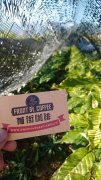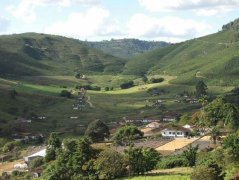The difference between coffee planting and orchard planting introduces how to manage the coffee plantation
The difference between coffee planting and orchard planting introduces how to manage the coffee plantation

Seedling stage: the seedling stage is the period from the germination of seeds (or cuttings, grafting) to the emergence of seedlings (the stage of raising seedlings in the nursery), about 0.5-1.5 years. After the coffee seeds were sown, the cotyledons began to be unearthed after a period of germination, which took about 30-100 days, and the length of time was closely related to temperature and humidity. After germination, the cotyledon seedlings should be transferred to a nutrition bag to raise seedlings, which takes 3-12 months to get out of the nursery.
Young tree stage: the period from planting to putting into production, about 2-3 years. The main feature of this period is exuberant vegetative growth, which can draw 6-8 pairs of branches every year, centering on the growth of roots, stems and leaves, and the aboveground and underground parts expand rapidly to form an ideal plant structure in preparation for production.
Production period: the first production period refers to the period from the beginning of production to the advent of high yield. during this period, coffee begins to enter reproductive growth, coffee trees grow vigorously, and there is a great demand for nutrients.
Full-blooming period: about 1-2 years after the first birth period, coffee trees generally bloom in 3-4 years, about 2-3 months a year, similar to jasmine in appearance and smell, growing in clusters on branches when flowering, and florescence 3-5 days. After the flowers bloom, they bear small green fruits, which ripen and turn red into ripe fruits that can be picked after a few months.
The skin of ripe fruit is red. Because its shape and color are similar to cherries, ripe coffee fruit is called coffe cherry in many places. Under the bright red pericarp, the peel, pulp and a sweet sticky yellow substance wrap the coffee beans.
It can last for about 30 years if it is properly managed.
Aging period: the growth is declining year by year, the economic life is nearing the end, and the coffee tree indicates that it is entering the aging period. Its life span is closely related to climate, soil and management level, and there are still century-old coffee trees that can blossom and bear fruit.
Important Notice :
前街咖啡 FrontStreet Coffee has moved to new addredd:
FrontStreet Coffee Address: 315,Donghua East Road,GuangZhou
Tel:020 38364473
- Prev

How to understand the whole process of Coffee planting in Yunnan Province
How to understand the whole process of coffee planting in Yunnan seedling stage: seedling stage is a period from seed (or cuttings, grafting) germination to seedling emergence (nursery stage), about 0.5-1.5 years. After the coffee seeds were sown, the cotyledons began to be unearthed after a period of germination, about 30-100 days, and the length of time
- Next

How to grow Coffee quality will be better Coffee planting Micro-environment introduction
How to grow coffee quality will be better coffee planting microenvironment introduces the origin of coffee trees in Ethiopia, Africa. In botany, coffee trees belong to the evergreen trees of the subgenus Rubiaceae, and coffee beans, commonly known as coffee beans, are the seeds of the fruit of coffee trees, just because they are shaped like beans, so they are called coffee beans. Climate is the decision of coffee cultivation.
Related
- Beginners will see the "Coffee pull flower" guide!
- What is the difference between ice blog purified milk and ordinary milk coffee?
- Why is the Philippines the largest producer of crops in Liberia?
- For coffee extraction, should the fine powder be retained?
- How does extracted espresso fill pressed powder? How much strength does it take to press the powder?
- How to make jasmine cold extract coffee? Is the jasmine + latte good?
- Will this little toy really make the coffee taste better? How does Lily Drip affect coffee extraction?
- Will the action of slapping the filter cup also affect coffee extraction?
- What's the difference between powder-to-water ratio and powder-to-liquid ratio?
- What is the Ethiopian local species? What does it have to do with Heirloom native species?

